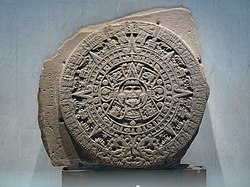
Pre-Columbian art
Art of the Pre-Columbian civilizations / From Wikipedia, the free encyclopedia
Dear Wikiwand AI, let's keep it short by simply answering these key questions:
Can you list the top facts and stats about Pre-Columbian art?
Summarize this article for a 10 years old
Pre-Columbian art refers to the visual arts of indigenous peoples of the Caribbean, North, Central, and South Americas from at least 13,000 BCE to the European conquests starting in the late 15th and early 16th centuries. The Pre-Columbian era continued for a time after these in many places, or had a transitional phase afterwards. Many types of perishable artifacts that were once very common, such as woven textiles, typically have not been preserved, but Precolumbian monumental sculpture, metalwork in gold, pottery, and painting on ceramics, walls, and rocks have survived more frequently.

The first Pre-Columbian art to be widely known in modern times was that of the empires flourishing at the time of European conquest, the Inca and Aztec, some of which was taken back to Europe intact. Gradually art of earlier civilizations that had already collapsed, especially Maya art and Olmec art, became widely known, mostly for their large stone sculpture.

Many Pre-Columbian cultures did not have writing systems, so visual art expressed cosmologies, world views, religion, and philosophy of these cultures, as well as serving as mnemonic devices. Artisans of the Ancient Americas drew upon a wide range of materials (obsidian, gold, spondylus shells), creating objects that included the meanings held to be inherent to the materials.[1] These cultures often derived value from the physical qualities, rather than the imagery, of artworks, prizing aural and tactile features, the quality of workmanship, and the rarity of materials.[1] Various works of art have been discovered large distances from their location of production, indicating that many Pre-Columbian civilizations interacted amongst each other. Many societies used raw materials carried from far away, suggesting difficulty of acquisition as a source of value.[1]
For many of these cultures, the visual arts went beyond physical appearance and served as active extensions of their owners and indices of the divine.[1] As spirituality was very prevalent among pre-columbian cultures, themes of the deities and ritual worship were often the subjects of artwork.